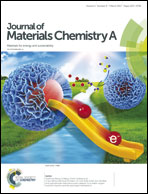Long-range charge transfer and oxygen vacancy interactions in strontium ferrite†
Abstract
The high oxygen non-stoichiometry (δ) in many mixed ionic conductors does not translate into high ionic conductivity due to strong interactions between oxygen vacancies. In this study, the charge states of Fe in various phases of SrFeO3−δ were determined by interpreting the density functional theory (DFT) predicted magnetic moment on Fe. The charge on Fe in square pyramidal (SP) was shown to always remain +4 while the Fe in distorted octahedral (Oh) varied from +4 to +3 with δ, due to the different d-orbital splitting of SP and Oh Fe. Furthermore, a new ‘long-range charge transfer’ mechanism was observed where the electrons left by the charge-neutral oxygen vacancy were transferred to the second nearest neighbor Fe (instead of the Fe directly connected to the vacancy) and resulted in extended lattice distortions that promoted strong oxygen vacancy interactions. A DFT-based thermodynamics model for interacting vacancies was also developed to predict the δ and oxygen vacancy site fraction (X) at high temperatures. The δ and X values calculated with this model showed good agreement with experiments. These calculations resolve a long-standing debate in the literature on the mixed charge states of Fe in SrFeO3−δ and identify a new mechanism for oxygen vacancy interactions.



 Please wait while we load your content...
Please wait while we load your content...